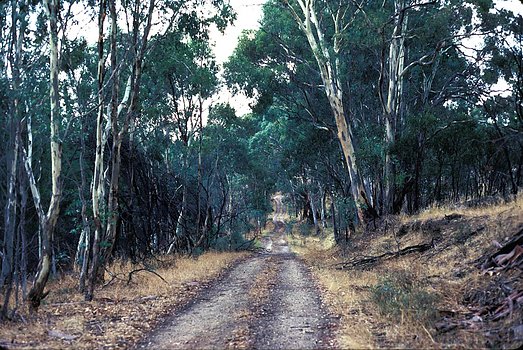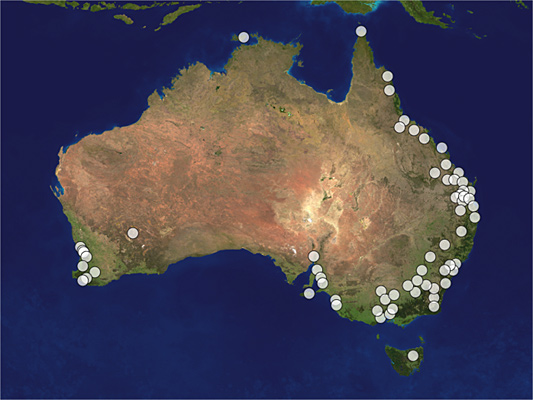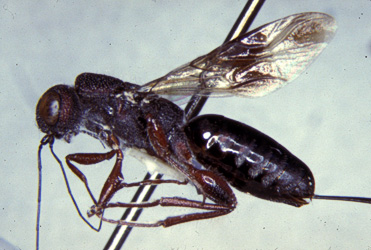Megalyra fasciipennis
Scott Richard ShawIntroduction
Megalyra fasciipennis is by far the most common and widespread of the Australian species. Large Australian megalyrids with banded wings and lateral tergal hair patches will usually belong to this species. This large wasp is found in Eucalyptus woodlands, where it attacks larvae of cerambycid beetles such as Phoracantha recurva (Hacker, 1913) in wood of old trees. The oviposition behavior was discussed by Rodd (1951). In Tasmania the species has been associated with several trees including Eucalyptus viminalis, E. ovata, E. vamaldulensis, Acacia dealbata, and Pinus radiata. This species was accidentally introduced to South Africa, presumably in imported lumber (Gess, 1964).


A Eucalyptus forest in South Australia, the typical habitat of Megalyra fasciipennis.


Distribution of Megalyra fasciipennis (adapted from Shaw, 1990); dots represent known collection localities. Satellite image courtesy of NASA / JPL.
Characteristics
Megalyra fasciipennis is easily recognized by its large body size (11-20 mm), long ovipositor (7-13 mm), banded wings with black patch at the apex of forewing, fine areolate sculpture on the antero-lateral areas of the propodeum, and metasoma with lateral patches of silvery hairs. The species can be identified using the key provided by Shaw (1990).
References
Gess, F.W. 1964. The discovery of a parasite of the Phoracantha beetle (Coleoptera: Cerambycidae) in the Western Cape. Journal of the Entomological Society of South Africa 27:152.
Hacker, H. 1913. Some field notes on Queensland insects. Memoirs of the Queensland Museum 2:96-98.
Rodd, N.W. 1951. Some observations on the biology of Stephanidae and Megalyridae (Hymenoptera). The Australia Zoologist 11:341-346.
Shaw, S. R. 1990. A taxonomic revision of the long-tailed wasps of the genus Megalyra Westwood (Hymenoptera: Megalyridae). Invertebrate Taxonomy 3:1005-1052.
Title Illustrations

| Scientific Name | Megalyra fasciipennis |
|---|---|
| Location | Australia |
| Specimen Condition | Dead Specimen |
| Life Cycle Stage | Adult |
| Size | 11-20 mm |
| Copyright |
© 2005 Scott Richard Shaw

|
About This Page
Mr. Dick Bashford (Tasmanian Forest Insect Collection) kindly provided data on the tree associations for this species in Tasmania.
Scott Richard Shaw

University of Wyoming, Laramie, Wyoming, USA
Correspondence regarding this page should be directed to Scott Richard Shaw at
Page copyright © 2005 Scott Richard Shaw
All Rights Reserved.
Citing this page:
Shaw, Scott Richard. 2005. Megalyra fasciipennis. Version 01 January 2005 (under construction). http://tolweb.org/Megalyra_fasciipennis/28887/2005.01.01 in The Tree of Life Web Project, http://tolweb.org/








 Go to quick links
Go to quick search
Go to navigation for this section of the ToL site
Go to detailed links for the ToL site
Go to quick links
Go to quick search
Go to navigation for this section of the ToL site
Go to detailed links for the ToL site